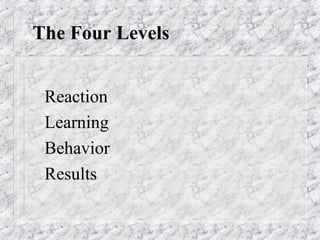Kirkpatrick developed a four-level model for evaluating training programs: (1) reaction, (2) learning, (3) behavior, and (4) results. The model provides a framework for assessing outcomes at each level to determine a training's effectiveness and identify ways to improve future trainings. Two case studies show how Intel and St. Luke's Hospital have applied the Kirkpatrick model in their evaluation processes, with Intel working backwards from level four and St. Luke's conducting statistical analysis of behavioral changes. The model offers a flexible approach to evaluation that can be tailored to different organizational needs.




































